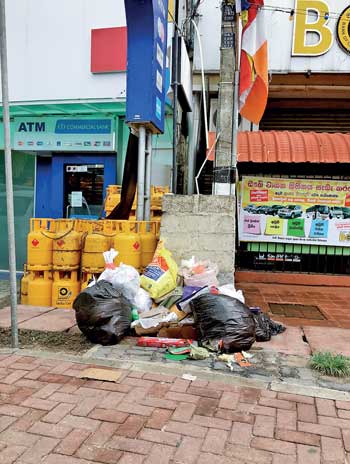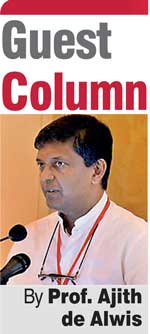Friday Jan 31, 2025
Friday Jan 31, 2025
Thursday, 25 May 2017 00:00 - - {{hitsCtrl.values.hits}}
Some may be wondering after Meethotamulla where all the Colombo waste is going. However, I do have a feeling that most had no idea whatsoever where things were disappearing into until the pictures of Meethotamulla came through their wide screens.
Initial Court orders of a few days to Karadiyana and Dompe, etc. met with strong opposition and those directions are no more taken. It is not the mayors who have to face the popular music but the tractor drivers and sanitation workers.
The absence of a place to deposit would mean CEB lamp posts perhaps getting buried with bags filled with household waste which in turn would attract animals of varying sizes as one need not guess about the attraction of fast food outlets to the animal world. It is an interesting social mystery why lamp posts are preferred for this particular purpose.
Post-Meethotamulla we all discussed the importance of waste segregation and doing your bit at home whenever possible. Media outlets did allocate some prime time slots for getting this message across. Time invariably passes and Sri Lankans do demonstrate their unique ability to listen and forget!
While one may oppose the display of a picture depicting a dead body being pulled out of the pile of collapsed garbage and buildings at Meethotamulla, in a call for action to do your own bit first, our action or rather the reactions sadly led us to interpret that they unfortunately did die in vain! We as a society enable mistakes to happen and never fully react positively to a situation taking whatever the lesson from an event. How many such situations can we recall!?

Meethotamulla disaster’s life lessons
The Meethotamulla disaster had many life lessons – to those who believe in bagging garbage and simply forgetting the rest of the journey and associated impacts, to those who were warned of danger and saw the cracks appearing yet perhaps ignored the call perhaps in favour of more payments or the fatal attraction to secondary economic activities courtesy the dump, decision makers who had many a chance yet went on business as usual, etc.
A collection of bags from a thousand places when placed over a small plot of land over time can give rise to a mountain of garbage with the potential to kill and we have unfortunately witnessed just that. One should not think that a nominal payment of a property rate to the Pradeshiya Sabha or a municipal council is going to absolve one from the responsibility of a generator.
Some of these prevailing rates are really insignificant and actually not worth the effort of collection and issuing a receipt in my view. Yet with such payments we expect a service of such high excellence. It is simply inexcusable that we have allowed such a situation to exist up to now. With a figure of 0.8 kg of solid waste per person per day in urban areas, we appear to top the league table in the region for waste generation. Yet our knowledge and the commitment to be part of the solution are far from satisfactory.
The waste keeps coming
I had the privilege of visiting the place where currently the Colombo waste is finding its way. Some have really risen to the immediate needs and probably have taken additional responsibilities to their shoulders. In a system where the circulars rule and sense has to take backstage, it is a pleasure to see teams who tread where even fools may hesitate.
Fortunately the intention at present appears to be not to create another mountain starting from scratch. Plenty of space with lot less receptors the show can go on for a number of years. However, this is not the intention of the group. Yes for a small number of days till a process transformation occurs dumping with a soil cover perhaps is the order of the day as there is no other viable option. It is also interesting to see how purists react when pragmatists are at work! Hope all strength is given to those who are bravely bearing the brunt of the smell and the burden but planning all the time towards that better solution.
However, my take from the visit is that despite significant media broadcasts the waste keep coming and the community at large is still interested in getting the garbage out rather than doing what they can and getting the right party to do what they cannot.
Trucks of varying sizes keep coming in and discharging their contents. The presence of wet organic loads is obvious. However, it appears that there is some segregation is taking place as in quite a few cases the organic fraction appears to be significant. Now if one takes a further step then this load interestingly can reduce too! 
What they should be doing is attending to the organic portion of one’s waste. This is by far the most significant component and still on site this is clearly evident. If one takes care of this portion, there would be much less to deal with by others and almost all of the rest can find different uses. That is the portion where we can easily indicate for wealth to reside!
There is wealth in the bio residue too – energy and fertiliser – yet those need some careful attention and some dedicated attending to derive those values. If neglected on the other hand this portion is quick to demonstrate via putrid offensive smell! The cardboard, plastics, aluminium cans and metals are not capable of the latter. That is why if we segregate these, the collection of these can happen may be once a week and then driven direct to recyclers via a transfer station.
As Sri Lanka lacks a developed food industry the degree of similarity of organic waste in Colombo is quite similar to that of the semi urban and the rural. The absence of a food process industry in turn also results in part of the lorry load of fruits and vegetables from provinces to be moved into dumps of Colombo straightaway. Yes we have been discussing post-harvest losses from time immemorial without some firm action. Hence waste at every step is what we have to observe still after all those well-intentioned seminars and projects.
Taking care of one’s waste
In Greater Colombo we have at maximum around 500,000 households. Colombo is known to generate around 700 MT of MSW per day. Considering that industries do not have the option of discharging their waste along with household waste, one could have a plan where near zero waste households are promoted as a goal.
Taking care of one’s waste within can have a tremendous impact on the waste management infrastructure of today. The impact is definitely very high as we do not have a processing option for the scale of waste that is currently present in Colombo. With the UDA sanctioned projects now slowly moving forward, in a two to three year time period, there will not be this issue at least at this magnitude. However from today till then we do have an issue and the population should be sensitive to the requirement.
The pressure that we have today can be converted into a positive outcome by going beyond the easy steps and internalising some work to happen within. These tiny commitments – this act of separation and the second act of composting and biogas – can transform Colombo if carried out in some scale. Starting from a thousand the number can grow and Colombo then will be known for something quite positive.
Publicity we can do without
In 1989 a writer for National Geographic on a special issue of waste unfortunately picked Colombo in the following manner – A solid waste consultant back from Sri Lanka tells me what he saw when the trucks reach the dumps of Colombo, the capital. The people rush forward first, then the cows ahead of the pigs and the goats because they are bigger. Last the crows. A miserable way of life? Undoubtedly…
It certainly was Sri Lanka’s bad luck to get figured in that way. Now in 2017 international news and social media buzzed with Meethotamulla and the number of dead again with garbage at the centre. Between 1989 and 2017 we appear to have done nothing much overall.
Well, this was publicity that we can do without. However, we can watch haplessly post-event how media reacts. Yet, if we learn and engage instead of allowing repetition, we can take charge and transform this city of ours. We do not have millions in our capital city. Colombo could still be manageable and if we unleash some creative and constructive behaviour the city can be transformed. That is why lessons should be learnt and implemented.
Execute at speed should be part of the mantra as we have lost a lot of time. All that is needed is all our minds taking a little bit more responsibility and collectively these would add up to a real big value. Media should give publicity to thousands who do join in for zero waste! They can spice up the act if they feel airing good news is boring but they must join in as otherwise sufficient momentum cannot be generated to reach the tipping point!